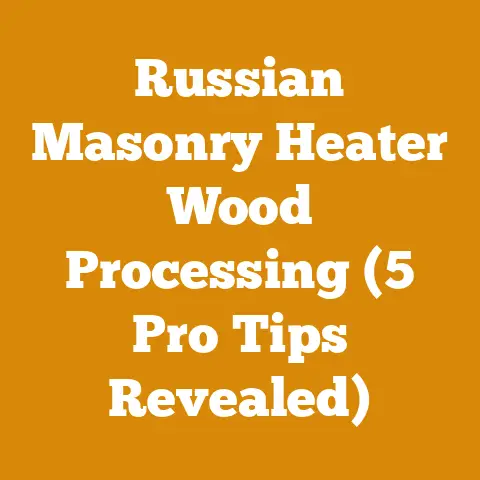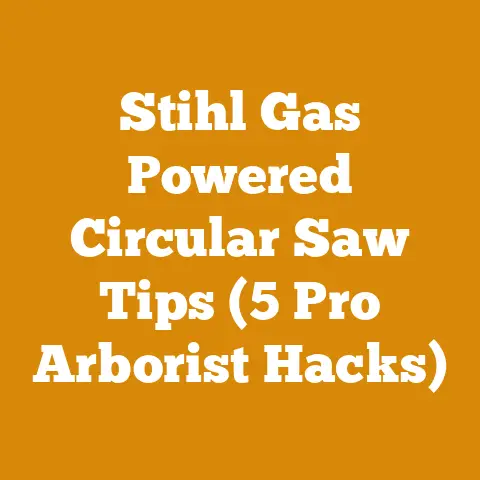Can I Get Poison Ivy in Winter? (5 Expert Tips for Safe Removal)
I’ve always been frustrated by the misconception that poison ivy is only a threat during the warmer months.
It’s a dangerous assumption that has led to many itchy, miserable winters for unsuspecting folks, myself included!
I remember one particularly harsh winter a few years back.
I was out gathering firewood, thinking I was in the clear from the green menace.
The woods were stark, the leaves were gone, and snow blanketed the ground.
Confident in my “winter immunity,” I wasn’t as careful as I usually am.
Big mistake!
A few days later, the telltale rash started appearing, proving that poison ivy is a year-round hazard.
That experience motivated me to learn everything I could about poison ivy, its winter survival strategies, and how to safely remove it, regardless of the season.
And because I’ve spent years working with wood, from felling trees to stacking cords of firewood, I understand the costs involved in keeping your property safe and clear of this pesky plant.
This article is born from that personal experience and research, offering you expert tips on how to identify and remove poison ivy safely, even when the snow is falling.
Can I Get Poison Ivy in Winter? (5 Expert Tips for Safe Removal)
The short answer is a resounding yes.
The longer, more nuanced answer explores why this is the case and what you can do to protect yourself.
Understanding the Winter Threat: Urushiol’s Stubborn Persistence
The culprit behind the itchy misery of poison ivy is urushiol, an oily resin found in all parts of the plant – leaves, stems, and roots.
Unlike some plants that completely die back in winter, poison ivy often retains its woody vines and even dried leaves.
And here’s the kicker: urushiol is incredibly stable.
It can remain active for years, even on dead plants.
Think of it like this: imagine a thin coating of super-sticky, invisible glue that causes an allergic reaction on contact.
This “glue” doesn’t just wash away easily.
It clings to surfaces and waits for an unsuspecting passerby.
Why Winter Doesn’t Kill Urushiol:
- Chemical Stability: Urushiol is a highly stable compound, meaning it doesn’t readily break down in cold temperatures or due to moisture.
- Persistence on Surfaces: It can adhere to clothing, tools, pet fur, and anything else that comes into contact with the plant.
- Dried Leaves and Vines: Even when the leaves are dry and brittle, the urushiol remains potent.
- Dormant Roots: The plant’s roots survive underground, ready to sprout new growth in the spring.
This means that even if you don’t see any visible plant matter above ground, urushiol may still be present in the soil.
Tip #1: Identifying Poison Ivy in Winter – Beyond the Leaves
Identifying poison ivy in winter requires a different approach than in the summer when the leaves are readily visible.
You need to focus on the plant’s structure and other telltale signs.
Key Identification Features:
- Hairy Vines: Look for hairy-looking vines climbing trees or snaking along the ground.
These vines are a dead giveaway, as very few other plants have this distinct characteristic. - “Leaves of Three, Let It Be” – Even Without Leaves: While the leaves may be gone, the arrangement of where the leaves were is still important.
Poison ivy leaves grow in clusters of three.
Look for the remnants of these clusters on the vines. - Berries: In late fall and winter, poison ivy often produces small, grayish-white berries.
These berries are a food source for some birds, but they contain urushiol and should be avoided. - Location, Location, Location: Poison ivy thrives in a variety of environments, but it’s commonly found along forest edges, roadsides, and in disturbed areas.
If you know poison ivy grows in a particular area, be extra cautious.
The Cost of Misidentification:
One of the biggest costs associated with poison ivy is not monetary, but rather in terms of time lost to illness and potential medical bills.
I remember a time when I misidentified a harmless vine as poison ivy.
I spent an entire afternoon meticulously avoiding it, only to later discover my mistake.
It was a waste of valuable time and effort.
Properly identifying poison ivy is crucial for efficient and safe removal.
Practical Example:
Imagine you’re clearing brush for a new firewood storage area.
You spot a vine climbing a tree.
Take a close look.
Does it have a hairy appearance?
Can you see the remnants of leaves arranged in groups of three?
Are there any grayish-white berries?
If you answer yes to these questions, proceed with extreme caution, assuming it’s poison ivy.
Tip #2: Gear Up for Winter Poison Ivy Removal: Protection is Paramount
Protecting yourself from urushiol exposure is the most crucial step in any poison ivy removal project, especially in winter.
The cold weather can lull you into a false sense of security, making you less vigilant about safety.
Essential Protective Gear:
- Gloves: Wear heavy-duty, chemical-resistant gloves, such as nitrile or vinyl gloves.
Avoid latex gloves, as urushiol can penetrate them.
I always double-glove for added protection. - Clothing: Cover as much skin as possible.
Wear long sleeves, long pants, and a hat.
Tuck your pants into your boots. - Eye Protection: Wear safety glasses or goggles to protect your eyes from urushiol exposure.
- Respirator (Optional but Recommended): If you’re burning poison ivy, wear a respirator to avoid inhaling urushiol-laden smoke, which can cause severe respiratory irritation.
- Barrier Cream: Apply a barrier cream, such as Ivy Block, to exposed skin before starting the project.
This cream creates a protective layer that can help prevent urushiol from penetrating the skin.
The Cost of Neglecting Protection:
Ignoring proper protective gear can be a costly mistake.
A severe poison ivy rash can lead to doctor’s visits, prescription medications, and lost workdays.
And believe me, the discomfort is not worth it!
Cost Breakdown (Estimated):
- Nitrile Gloves (Box of 100): $10 – $20
- Safety Glasses: $5 – $15
- Respirator: $20 – $50
- Barrier Cream: $10 – $20
- Medical Visit (If Needed): $100 – $300 (or more, depending on insurance)
- Prescription Medication (If Needed): $20 – $100 (or more, depending on insurance)
Investing in proper protection is a small price to pay compared to the potential costs of a poison ivy rash.
Personal Story:
I once tried to save a few bucks by using a pair of old gardening gloves that I thought were still in good condition.
Big mistake!
Urushiol seeped through the worn-out material, resulting in a nasty rash on my hands.
I learned my lesson the hard way: always use high-quality, chemical-resistant gloves and replace them regularly.
Tip #3: Choosing the Right Removal Method: Chemical vs. Mechanical
There are two primary methods for removing poison ivy: chemical and mechanical.
Each method has its advantages and disadvantages, and the best choice for you will depend on the size of the infestation, your personal preferences, and your budget.
Chemical Removal:
- Herbicides: Herbicides containing glyphosate or triclopyr are effective at killing poison ivy.
However, they can also harm other plants, so use them carefully. - Application: Apply the herbicide directly to the leaves and stems of the poison ivy.
Follow the instructions on the product label carefully. - Timing: The best time to apply herbicides is when the plant is actively growing, typically in the spring or summer.
However, you can still apply herbicides in the winter, especially on warmer days.
Mechanical Removal:
- Hand Pulling: For small infestations, you can pull poison ivy by hand.
Wear gloves and long sleeves, and be sure to remove the entire root system. - Cutting: Cut the vines at the base of the plant and then dig up the roots.
- Smothering: Cover the poison ivy with cardboard or black plastic to block sunlight and kill the plant.
This method takes several months to be effective.
Cost Comparison:
| Method | Materials Required just be the most expensive choice in the long run.
The Labor Cost Factor:
Here’s where things get interesting.
If you’re comfortable doing the work yourself, mechanical removal can be the cheaper option upfront.
However, your time has value.
Consider the opportunity cost of spending hours pulling poison ivy versus, say, working on a side project or enjoying your free time.
If you hire a professional landscaping company to remove the poison ivy, the labor costs can significantly increase the overall price.
Labor Cost Estimates (Professional Removal):
- Hourly Rate: $50 – $100 per hour (depending on location and experience)
- Project-Based Fee: Some companies may charge a flat fee based on the size of the infestation and the complexity of the removal.
My Recommendation:
For small infestations, I prefer mechanical removal.
It’s more environmentally friendly and allows me to get some exercise.
However, for large infestations or areas that are difficult to access, I might consider using a herbicide, but always with extreme caution and careful application.
Tip #4: Disposing of Poison Ivy Safely: Containment is Key
Proper disposal of poison ivy is crucial to prevent further exposure and spread.
Simply tossing it in the compost pile is a recipe for disaster!
Safe Disposal Methods:
- Bagging: Place the poison ivy in heavy-duty plastic bags and seal them tightly.
Label the bags clearly as “Poison Ivy” to warn others.
Dispose of the bags according to your local regulations. - Burning (With Caution): Burning poison ivy can be an effective way to destroy it, but it’s also very dangerous.
The smoke contains urushiol, which can cause severe respiratory irritation.
If you choose to burn poison ivy, do so in a controlled environment, away from buildings and other flammable materials.
Wear a respirator and be sure to check local regulations regarding burning.
I personally avoid this method unless absolutely necessary. - Burying: Burying poison ivy is another option, but it’s not always effective.
The roots can survive underground and sprout new growth.
If you choose to bury poison ivy, bury it deep (at least 12 inches) and cover it with a thick layer of soil.
Never Compost Poison Ivy!
Composting poison ivy is a surefire way to contaminate your entire compost pile with urushiol.
Avoid this at all costs!
Cost Considerations:
- Heavy-Duty Plastic Bags: $5 – $10 per pack
- Disposal Fees (If Applicable): Some landfills may charge a fee for disposing of yard waste.
- Respirator (If Burning): $20 – $50
My Approach:
I typically bag the poison ivy and dispose of it with my regular trash.
It’s the safest and most convenient option for me.
Important Note:
Always wash your tools and clothing thoroughly after handling poison ivy.
Urushiol can cling to surfaces for years, so it’s important to decontaminate everything that may have come into contact with the plant.
Tip #5: Aftercare and Prevention: Stopping Future Outbreaks
Removing poison ivy is only half the battle.
You also need to take steps to prevent it from coming back.
Aftercare Strategies:
- Monitor the Area: Regularly inspect the area where you removed the poison ivy for any new growth.
- Mulch: Apply a thick layer of mulch to suppress weed growth and prevent poison ivy from sprouting.
- Plant Ground Cover: Plant a dense ground cover to compete with poison ivy for resources.
- Herbicide (As Needed): If new growth appears, apply a herbicide directly to the leaves and stems.
Prevention Tips:
- Learn to Identify Poison Ivy: The better you are at identifying poison ivy, the easier it will be to avoid it.
- Wear Protective Gear: Always wear gloves, long sleeves, and long pants when working outdoors, especially in areas where poison ivy is known to grow.
- Wash Your Skin: If you think you may have come into contact with poison ivy, wash your skin immediately with soap and water.
- Wash Your Clothing: Wash your clothing in hot water with detergent after working outdoors.
- Use Barrier Cream: Apply a barrier cream to exposed skin before working outdoors.
The Long-Term Cost of Neglect:
Ignoring aftercare and prevention can lead to recurring poison ivy infestations, which can be costly and time-consuming to manage.
Cost-Effective Prevention:
- Mulch: A bag of mulch costs around $5 – $10 and can cover a significant area.
- Ground Cover Plants: The cost of ground cover plants varies depending on the species and the size of the area you want to cover.
My Long-Term Strategy:
I’ve adopted a multi-pronged approach to poison ivy prevention.
I regularly monitor my property for new growth, apply mulch to suppress weeds, and plant ground cover to compete with poison ivy.
I also make sure to wear protective gear whenever I’m working outdoors.
Final Thoughts:
Dealing with poison ivy, especially in winter, can be a challenge.
But by following these expert tips, you can protect yourself from the itchy misery and keep your property safe.
Remember, knowledge is power, and prevention is key.
And don’t underestimate the stubborn resilience of urushiol – it’s a year-round threat that demands respect and vigilance.






